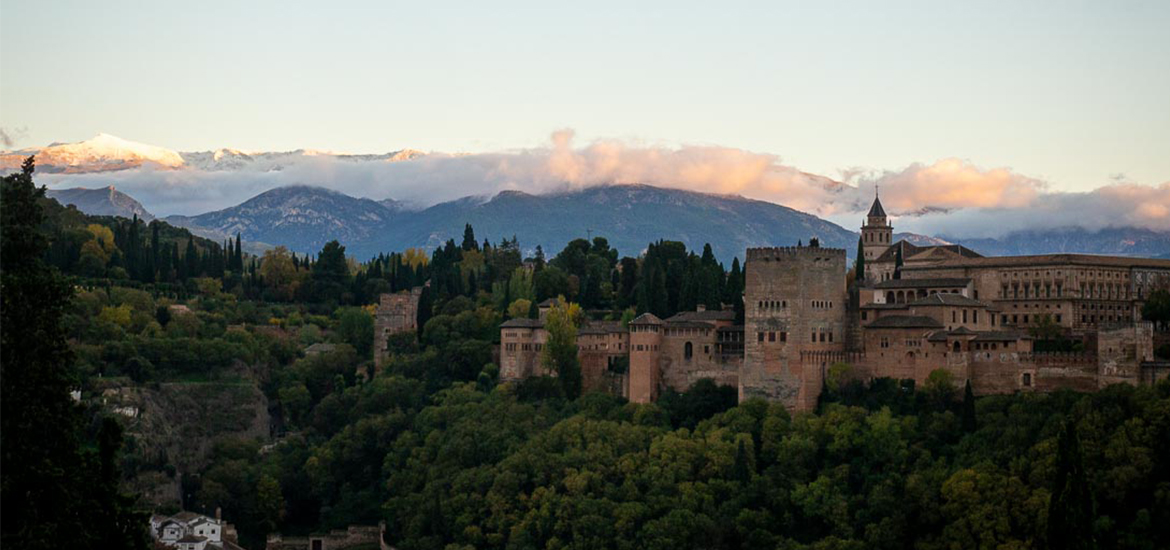Our Portugal & Andalucia Trip
Lisbon | Sintra | Lagos | Seville | Granada | Ronda | Cordoba
“Give him alms, woman, because there is nothing sadder in life than being blind in Granada”
Francisco de Icaza
Named for the Spanish word for “pomegranate,” the Moorish heart of Andalusia and picturesque city of Granda is nestled at the foot of the Sierra Nevada mountains, and is rich with history of Christian and Muslim legacies. No Andalucian trip is complete without a visit to the Alhambra, the city’s stunning hilltop palace.
Granada is also the place to try Moroccan cuisine and roam through the winding streets of the Albaicín neighborhood for dramatic views and historic house facades.
We spent just shy of a full day in Granada, with an afternoon arrival and exploration, and morning entry time at the massive Alhambra complex.
Alhambra & Generalife
The fortress overlooking the city has endured the Reconquista, many changes of hands and lots of vandalism (19th-century tourists were keen to take home pieces of the palace), but remains beautifully preserved today in its gorgeous royal rooms, Islamic art and striking courts. The name Alhambra refers to its red color visible as the setting sun strikes its outer walls.





This popular destination sells out months in advance, so make sure to buy tickets online well in advance of your trip. We combined it with the Generalife gardens and purchased the morning’s first time slot to walk through the Nasrid Palaces with a very helpful audioguide picked up from a cart outside the queue. Like sultans, emperors and kings of old who called this place home, you’ll wander through and enjoy all the details, from arched ceilings to fountains and inscriptions. We spent an hour touring the Nasrid Palace, and almost two and a half in the Generalife.




Albaicín
The evening of our arrival, we ate dinner then crossed into the city’s quiet, historic Albaicín district. Sunset was just about to strike the Alhambra from the view at the Mirador de San Nicolas, so we were in a full sprint, leaping up winding stairs and white-washed alleys under balconies lush with trailing plants and ornate iron window bars until we came upon the crowd gathered for the scene.



With so many clouds at dusk, we didn’t get our quintessential “red castle,” but we did enjoy a gorgeous panorama of the indomitable Alhambra flanked with the snow-capped Sierra Nevadas. There were lots of people kicking back to enjoy the view. After we swapped some photo-taking responsibilities, we clambered back downhill and peeked through the alleys along the way. The Mirador de Los Carvajales offered another beautiful view of the fortress.


Historic Center
The sights of the historic city centre are clustered around the Catedral de Granada. In the Plaza de las Pasiegas by its grand facade, notice the paint detail on the buildings made to look like plaster ornamentation. Nearby to the south, there is a neat alcove marked with an arch called the Corral del Carbón that was once a former caravanserai: a Moorish roadside inn where traders could rest up.

As our trip neared its end, we eschewed more cathedral interiors for wandering around side streets. Finding pomegranate accents turned into a fun scavenger hunt.


Shopping & Eating
The touristy Alcaiceria was once a bazaar of Arabic silks, spices and goods, but now you’re more likely to find (and photograph) the ceilings of low shops decked with gorgeous stained glass lamps. We bought lots of souvenirs around this area, including olive oil soap from the surrounding region and chocolate bars from the cool spice shop and tea store called Medievo.

We stumbled across Restaurante Arrayanes online and enjoyed the ambiance, milky tea and great Moroccan food. If you want a local dessert, find a bakery advertising the Piononos de Santa Fe. This pricey little pastry is traditional to a small town nearby and is made of rolled dough, syrup and toasted cream.

It’s not unique to Granada, but I’m going to stop and talk about jamón here, since I took these pictures while walking the city. Spain’s favorite dry-cured ham will be topping your breakfast sandwiches, your lunch spread and dangling in rows of full legs from shop fronts and restaurant rafters. Jamón Ibérico is the local variety, made from black Iberian pigs fed acorns or chestnuts – and jamón ibérico de bellota guarantees it got to wander the oak forests on an acorn-only foraging diet before gracing your plate. You’ll see ham stands all over with the delicately poised hoof locked in a brace, ready to be sliced.

Churros con chocolate is also not a particular Granada specialty, but we had a really good plate at Café Fútbol in the Realejo district. We also had a cheap drink underneath the lit Alhambra fortress at one of the outdoor bars along the walkable Paseo de los Tristes.

Where We Stayed
Unbeknownst to me despite booking it myself, the Palacio De Mariana Pineda is not only one of the most beautiful hotels we stayed at, but a historical 1600s palace with a central patio and only five rooms. Our suite connected a bathroom down the hall to a gorgeous room with a canopy bed and balcony with a view of the Alhambra and walkway and tree-lined creek below.




























